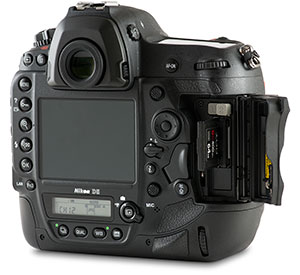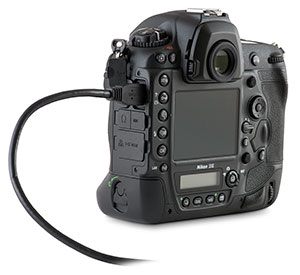 Camera Memory Speed
Camera Memory SpeedMemory Card Comparison & Performance Tests for Digital Cameras

Nikon D5 XQD Card Comparison
Published: April 12, 2016
The Nikon D5 is the flagship full-frame DSLR introduced in 2016. It offers 12 fps continuous shooting (14 fps with the mirror locked up). It is offered in two versions: one with dual CompactFlash slots and one with dual XQD slots. For extended burst shooting performance, the dual XQD card version offers superior performance. This comparison of six XQD cards in the Nikon D5 shows the average write speed during continuous shooting, which is well above what is possible with CF cards. A second table compares the cards in terms of the number of shots in 30 seconds using different image modes.
Write Speed Test
Test date: April 5, 2016
The write speed test uses 14-bit uncompressed RAW (.NEF) image format to measure average write speed during continuous shooting. This mode results in the largest file size and highest average write speed. The D5 is set to full manual and options that require additional processing are disabled. The shutter mode is set to Continuous High 12fps and the lens is manually focused on a detailed test scene. The resulting images are 43MB RAW files. The write speed is the total data written to the card divided by the write time in seconds. Each card is tested three times and the resting write speed is the average. Results are in MB/s where 1 MB = 1,048,576 bytes. Higher numbers represent faster cards.
| Memory Card | Average Write Speed (MB/s) | Price |
|---|---|---|
| Lexar Professional 2933x XQD 64GB | ||
| Sony G-Series 400MB/s XQD 64GB | ||
| Lexar Professional 1400x XQD 64GB | ||
| Sony S-Series 168MB/s XQD 32GB | ||
| Sony M-Series XQD 64GB | ||
| Sony M-Series XQD 32GB |
Continuous Shooting Test
The continuous shooting test shows how many images the D5 can take in 30 seconds using each XQD card (not including buffer clearing time). Three image modes are used: RAW+JPEG, RAW, and JPEG. In addition to image type and camera settings, the subject of the photograph can affect the number of shots. Less detailed subjects create smaller file sizes and write faster. The detailed test scene creates relatively large files. In continuous shooting this shows the difference between memory cards rather an absolute maximum that may be quoted by a camera manufacturer. Note that the 1/60 shutter speed used in this test effectively reduces the 12 frame per second rate to about 10 frames per second. This does not affect the results over the 30 second duration of the test except in JPEG mode where the camera is not buffer limited with faster cards.
Settings:
RAW: 14-bit uncompressed (average 43MB .NEF file size)
JPEG: Large, fine quality (average 10.4MB .JPG file size)
| Memory Card | Continuous Shooting – Images in 30 Seconds | Lowest Price | ||
|---|---|---|---|---|
| RAW+JPEG | RAW | JPEG | ||
| Lexar Professional 2933x XQD 64GB | ||||
| Sony G-Series 400MB/s XQD 64GB | ||||
| Lexar Professional 1400x XQD 64GB | ||||
| Sony S-Series 168MB/s XQD 32GB | ||||
| Sony M-Series XQD 64GB | ||||
| Sony M-Series XQD 32GB | ||||
D5 Performance Analysis
The D5 with dual XQD slots and offers extremely high performance when used with fast XQD cards. Write speeds during continuous shooting measured up to 293.8 MB/s (highest individual test result). Not all XQD cards are capable of such high write speed. The recently released Sony M-Series cards have particularly lackluster write performance. The 32GB M-Series advertises 80MB/s write speed but measured only 41.2 MB/s average during continuous shooting. The 64GB M-Series advertised at 150MB/s write speed averaged 72.4MB/s write speed.
The slowest card measured in the D5 was the Sony M Series 32GB. In continuous shooting uncompressed RAW it managed about 5 seconds of continuous shooting (58 frames) before the buffer limited the frame rate. The fastest card, the Lexar 2933x, provided over 15 seconds of continuous uncompressed RAW, and essentially unlimited lossless compressed RAW (the camera imposes a 200 shot limit but the shutter can be pressed again to reset the counter and continue shooting).
Using Two XQD Cards
The D5 provides dual card slots which can be used in three different modes. In normal operation (overflow) the second card is used after the first card is filled. Backup mode writes the same images to both cards. The third mode allows RAW and JPEG to be written to separate cards.
When RAW and JPEG are written to separate XQD cards there was essentially no performance benefit compared with writing both to the first card; approximately the same number of images were taken in a 30 second interval.
In backup mode the number of images was reduced by 15% to 35% compared with writing images to only the slower card.
| Mode: Overflow | RAW + JPEG | RAW | JPEG |
|---|---|---|---|
| Lexar Professional 2933x XQD 64GB | 191 | 254 | 299 |
| Sony G-Series XQD 64GB | 180 | 243 | 299 |
| Mode: Backup Card 1 & Card 2 | RAW + JPEG | RAW | JPEG |
| Lexar Professional 2933x XQD 64GB (Card 1) Sony G-Series XQD 64GB (Card 2) | 115 | 154 | 299 |
| Mode: RAW Card 1 / JPEG Card 2 | RAW + JPEG | ||
| Lexar Professional 2933x XQD 64GB (RAW) Sony G-Series XQD 64GB (JPEG) | 188 |
When comparing write modes using slow XQD cards such as the Sony M-Series XQD only a slight difference was seen when recording RAW+JPEG to separate cards. The test used the slower card in Slot 1 to illustrate the difference. In actual use the faster card should be used in Slot 1 where the larger RAW files will be recorded.
| Mode: Overflow | RAW + JPEG | RAW | JPEG |
|---|---|---|---|
| Sony M-Series XQD 64GB | 89 | 107 | 287 |
| Sony M-Series XQD 32GB | 70 | 82 | 200 |
| Mode: Backup Card 1 & Card 2 | RAW + JPEG | RAW | JPEG |
| Sony M-Series XQD 32GB (Card 1) Sony M-Series XQD 64GB (Card 2) | 58 | 69 | 159 |
| Mode: RAW Card 1 / JPEG Card 2 | RAW + JPEG | ||
| Sony M-Series XQD 32GB (RAW) Sony M-Series XQD 64GB (JPEG) | 72 |
Recommended XQD Cards for the Nikon D5
 For the best performance, the Lexar Professional 2933x 64GB XQD 2.0 was the fastest XQD card tested in the D5. It averaged over 292.9 MB/s write speed during continuous shooting. The runner up was the Sony G Series 64GB XQD Card which averaged 273.9 MB/s write in the D5. Both these cards are ideal for extended continuous shooting of RAW images. When shooting 14-bit compressed or lossless compressed RAW images, the Lexar 2933x card provided unhindered shooting (up to the camera-imposed 200 shot limit and beyond when the shutter is pressed again).
For the best performance, the Lexar Professional 2933x 64GB XQD 2.0 was the fastest XQD card tested in the D5. It averaged over 292.9 MB/s write speed during continuous shooting. The runner up was the Sony G Series 64GB XQD Card which averaged 273.9 MB/s write in the D5. Both these cards are ideal for extended continuous shooting of RAW images. When shooting 14-bit compressed or lossless compressed RAW images, the Lexar 2933x card provided unhindered shooting (up to the camera-imposed 200 shot limit and beyond when the shutter is pressed again).
Other cards such as the Lexar 1400x, Sony M-Series and older Sony S-Series cards reduced performance, but are still suitable for shooting JPEG or for those who do not require extended continuous shooting beyond the camera's buffer.

Transferring images from the D5: USB 3.0 cable vs card reader
The D5 features a USB 3.0 port to transfer images directly from the camera. To test transfer speed a USB 3.0 cable was used to connect the camera to a computer equipped with an SSD drive. The fastest card, the Lexar Professional 2933x 64GB XQD averaged 105.6 MB/s when transferring 3.4GB of RAW files. The same card in the Lexar XR2 XQD 2.0 reader averaged 246.8 MB/s transfer rate. See the Card Reader Reviews for more card reader tests and benchmarks.